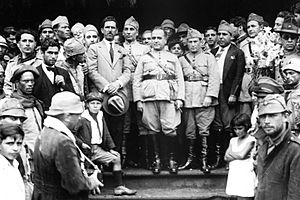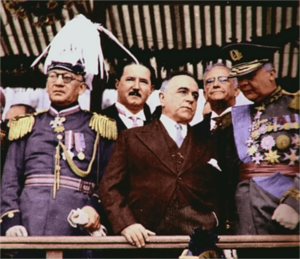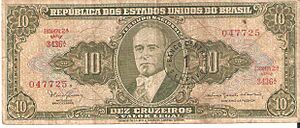Vargas Era facts for kids
Quick facts for kids
Republic of the
United States of Brazil República dos
Estados Unidos do Brasil |
|||||||||
|---|---|---|---|---|---|---|---|---|---|
| 1930–1946 | |||||||||
|
Motto: "Ordem e Progresso"
"Order and Progress" |
|||||||||
|
Anthem: Hino Nacional Brasileiro
(English: "Brazilian National Anthem") |
|||||||||
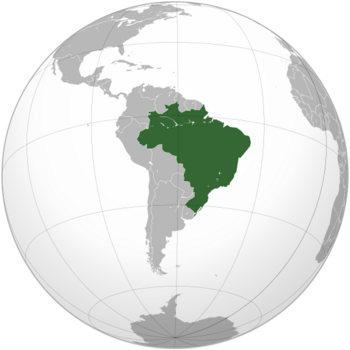 |
|||||||||
| Capital | Rio de Janeiro | ||||||||
| Common languages | Portuguese | ||||||||
| Government | Federal provisional government (1930–1934)
Federal presidential republic (1934–1946)
|
||||||||
| President | |||||||||
|
• 1930
|
Military Junta | ||||||||
|
• 1930–1945
|
Getúlio Vargas | ||||||||
|
• 1945–1946
|
José Linhares | ||||||||
| Historical era | Interwar period · World War II | ||||||||
|
• Revolution of 1930
|
3 October 1930 | ||||||||
|
• New Constitution
|
16 July 1934 | ||||||||
|
• Communist uprising
|
23 November 1935 | ||||||||
|
• Estado Novo coup
|
10 November 1937 | ||||||||
|
• Entry into WWII
|
22 August 1942 | ||||||||
| 24 October 1945 | |||||||||
|
• Ousting of Vargas
|
29 October 1945 | ||||||||
|
• Democratic Constitution
|
18 September 1946 | ||||||||
| Currency | Brazilian real (1930–1942) Cruzeiro (1942–1946) |
||||||||
|
|||||||||
The Vargas Era (in Portuguese: Era Vargas) was a special time in the history of Brazil. It lasted from 1930 to 1946. During this period, Getúlio Vargas was the president and leader of the country.
This era is divided into two main parts. The first part, from 1930 to 1937, is called the Second Brazilian Republic. The second part, from 1937 to 1946, is known as the Third Brazilian Republic or Estado Novo.
The Vargas Era began with the Brazilian Revolution of 1930. This event ended the previous government, known as the First Brazilian Republic. President Washington Luís was removed from power. A new provisional government, led by Vargas, took over. This change meant that the old rules and the 1891 Constitution were no longer in effect.
Vargas's time in power included three main phases:
- Provisional Government (1930–1934): Vargas ruled by special orders while a new Constitution was being created.
- Constitutional Government (1934–1937): A new Constitution was written and approved. Vargas was then elected president under this new system.
- Estado Novo (1937–1946): Vargas changed the Constitution again to stay in power. He became a dictator, meaning he ruled without a legislature or elections.
The Vargas Era ended in 1945 when Getúlio Vargas was removed from power. This led to Brazil becoming a democracy again with a new Constitution in 1946. This marked the start of the Fourth Brazilian Republic.
Contents
End of the Old Republic
Brazil's economy relied heavily on selling coffee to other countries. When the Great Depression hit in 1929, the price of coffee dropped a lot. This caused big problems for Brazil.
Between 1929 and 1931, coffee prices fell by a huge amount. Brazil earned much less money from its exports. The government had trouble supporting the coffee industry, which was the backbone of the economy.
The government of President Washington Luís faced a big money crisis. The coffee farmers had too much coffee they couldn't sell. The government's policies made things worse, and many people were unhappy. This made the government weak and easy to overthrow.
Rise of Getúlio Vargas
Getúlio Vargas was a governor from the state of Rio Grande do Sul. He was a lawyer and a cattle rancher. In 1930, he ran for president with the Liberal Alliance.
Vargas had new ideas for Brazil. He wanted to help the country grow its own industries and make changes that would benefit the nation. He was popular with people in cities and those who wanted to see Brazil develop. He also got support from some military officers.
Vargas understood that factory workers could become a new source of political power. He used this idea to gain control and stayed in power for 15 years. During his rule, new leaders from cities and the middle class gained more influence.
Brazil's politics had long been dominated by the states of São Paulo (known for coffee) and Minas Gerais (known for milk). This was called café com leite ("coffee with milk") politics. However, many people in other states, especially the northeast, were unhappy with this system.
Vargas formed an alliance with groups that were against the old government. He chose João Pessoa from the northeastern state of Paraíba as his running mate. This helped him gain support from landowners in the northeast.
Vargas promised to help the middle class and promote industry. He used popular ideas to bring together different groups who wanted change. This alliance helped him come to power in the 1930 revolution.
Second Brazilian Republic
Vargas's government had a general goal of "modernization." He tried to balance the different groups that supported him. His policies were similar to those in fascist Italy under Benito Mussolini in some ways. He also focused on helping people, much like the "New Deal" in the United States. U.S. President Franklin D. Roosevelt even called Vargas one of the inventors of the New Deal.
Vargas wanted to help Brazil recover from the Great Depression. He used government power to boost industries and meet the needs of the growing middle class. He encouraged Brazilian industries by adding taxes on imported goods. He said it would be "unpatriotic" to buy foreign products.
He also tried to solve problems between workers and business owners. For example, he helped end a strike by female factory workers. He made sure that workers' groups would use government help to solve future problems.
The government also focused on farming. To keep the support of powerful landowners, Vargas did not make big changes to land ownership. He also did not give farm workers the same benefits as city workers. This made the differences between the poor northeast and the richer southeast even bigger.
Some powerful coffee growers in São Paulo did not like Vargas's strong government control. They also disliked his policies that seemed to favor industry over agriculture.
Moving Towards Dictatorship
In 1932, there was a revolt in São Paulo. The coffee growers tried to take back control of the government. Vargas had appointed a new governor for São Paulo who was not liked by the local elite. This governor tried to make economic changes, which worried the coffee growers.
Even though the revolt failed, Vargas tried to get the support of the landowners again. He made some promises, like not changing land ownership. He also helped coffee planters with their debts. These actions made some of his earlier supporters, especially those on the left, unhappy.
Vargas also faced threats from communist groups who wanted land reform. Since Vargas came to power with the help of landowners, he could not meet these demands.
By 1934, Vargas started to control labor unions more strictly. He also moved closer to the Integralists, a Brazilian group similar to fascists in Europe. His government began to suppress opposition, especially from the left.
Economic Growth
Vargas's economic policies were designed to boost industrial growth and control the working class. In 1934, a new Constitution was put in place. It gave the government more power over the economy. It aimed to unite all classes for the good of the country, similar to ideas in Fascist Italy.
This new Constitution created a system where industries were organized into state-controlled groups. It encouraged industrialization and aimed to reduce Brazil's reliance on foreign goods. The government invested in important industries like mining, oil, steel, and electricity. Foreign companies also invested in Brazil to sell their products inside the country.
The 1934 Constitution also worked to centralize power in Rio de Janeiro. This meant reducing the power of individual states. This helped to modernize the government and reduce the influence of local powerful figures.
Third Brazilian Republic (Estado Novo)
Vargas's term as president was supposed to end in 1938. However, on November 10, 1937, Vargas announced on the radio that there was a communist plot to overthrow the government. This was called the "Cohen Plan." In reality, this plan was made up by the government itself. Vargas used it as an excuse to stay in power.
Before this, in 1935, communists had tried to take over the government in a failed coup. Because of this, Congress had already given Vargas more power. They also created a "National Security Tribunal" to deal with political crimes.
On November 10, 1937, Vargas declared a state of emergency and closed down the Legislature. He announced a new, very strict Constitution that gave him all the power. He called this the "New State" (Estado Novo). This showed that he had planned to take full control for a while.
Under the Estado Novo, the National Security Tribunal became a permanent court. It judged anyone accused of being a threat to the government. The police also gained a lot of power, especially the "Department of Political and Social Order" (DOPS), which acted as a secret police.
The 1937 Constitution said there would be elections for a new Congress, but these elections never happened. Vargas ruled for eight years as a dictator, almost like under martial law. He also controlled the courts and the states, appointing federal "interventors" to govern them.
In December 1937, Vargas banned all political parties, including the fascist-like "Brazilian Integralist Action" (AIB). The Integralists had supported Vargas before, but they were angered by this. In May 1938, they even tried to overthrow Vargas, but they failed.
During the Estado Novo (1937-1945), Vargas continued to build up Brazil's industries. He promoted economic nationalism, meaning he wanted Brazil to be strong and independent economically. He was called the "Father of the Poor" because he gained support from the working class and indigenous people. He wanted to help them improve their lives and unite society.
Many important industrial organizations were created during this time, such as:
- The "National Oil Advisor" (CNP)
- The "National Iron Smelting Company" (CSN)
- The "Rio Doce Valley Company" (Vale S.A.)
The Estado Novo also had a big impact on city planning in Brazil. It allowed for large-scale urban planning. Cities like Curitiba received their first plans during this period.
To stop people from opposing him, Vargas used censorship. The "Department of Press and Propaganda" (DIP) controlled the media and promoted the government's ideas.
In 1943, Vargas introduced the Consolidation of Labor Laws (CLT). This law gave workers many rights, such as stable jobs after ten years, weekly rest, rules for child and women's labor, and an eight-hour workday.
Brazil and World War II
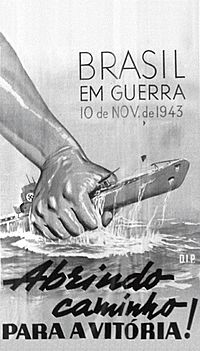
When World War II started in 1939, Brazil remained neutral at first. In 1941, an agreement was made for American countries to support each other if attacked. After the attack on Pearl Harbor, it was clear Brazil would eventually join the war.
The United States helped Brazil by financing iron ore and steel production. They also built military bases along Brazil's coast. In 1942, Vargas signed an agreement to supply natural rubber from the Amazon to the Allies. This led to many people moving from the dry northeast to the Amazon to work as "rubber soldiers."
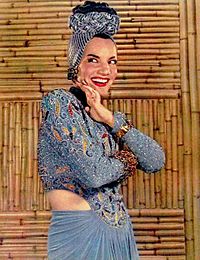
After German and Italian submarines sank over 25 Brazilian merchant ships in 1942, people demanded action. Brazil declared war on Nazi Germany and Fascist Italy in August 1942.
In January 1943, Vargas and U.S. President Franklin Delano Roosevelt met. They agreed to create the Brazilian Expeditionary Force (BEF). In July 1944, the first BEF troops were sent to fight in Italy. Even though they were not well-equipped, they completed their missions.
After the war ended in 1945, the government was worried about the BEF's popularity. They quickly sent the soldiers home and placed restrictions on them. Civilian veterans could not wear military decorations, and military veterans were sent to remote areas.
The war and its end increased pressure for Brazil to become a democracy again. Vargas made some changes, like setting a date for elections and freeing political prisoners. However, he could not keep his power. On October 29, 1945, the military removed him from office in a surprise move.
After Vargas was removed, José Linhares, the head of Brazil's Supreme Court, became president temporarily. He immediately called for new elections for president and a new assembly to write a Constitution. The elections were held in December 1945. José Linhares stayed in office until January 31, 1946, when the new president, General Eurico Gaspar Dutra, took office. This marked the end of the Estado Novo and the beginning of the Fourth Brazilian Republic.
See also
- Estado Novo (Portugal)
- Brazilian Integralism
- Second presidency of Getúlio Vargas
- Estado Novo (Brazil)




